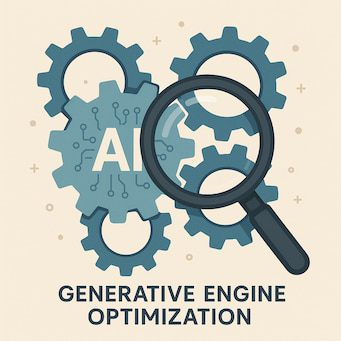• SEO & AI Strategy
Generative Engine Optimization (GEO): Strategies to Enhance Your Brand's Visibility in AI-Powered Search
The rise of AI search tools demands a new approach: GEO. Learn how to adapt and ensure your brand is seen.

The digital marketing landscape is in constant flux, but the recent surge in AI-powered search tools marks one of its most significant transformations yet. For years, Search Engine Optimization (SEO) has been the cornerstone of online visibility. But with the rise of AI chatbots like ChatGPT, Google's Search Generative Experience (SGE), Perplexity AI, and others, a new paradigm is emerging: Generative Engine Optimization (GEO).
Contextualizing the Evolution: From SEO to GEO
Traditional SEO involves optimizing website content, technical aspects, and authority signals to appeal to search engine algorithms. While these elements remain crucial, AI-driven search introduces a new layer. These "generative engines" don't just list links; they synthesize information to provide direct, conversational answers. GEO, therefore, is the evolution of SEO, adapting strategies to ensure your brand's information is not only discoverable but also *selected and presented* by these AI models.
The Importance of GEO
Why is this shift so critical? Users are increasingly turning to AI chatbots for quick, comprehensive answers. If your brand isn't part of that AI-generated narrative, you risk becoming invisible. Optimizing for AI-generated responses is no longer a futuristic concept; it's a present-day necessity for maintaining and enhancing digital visibility.
Understanding How AI Chatbots Recommend Content
To effectively optimize for generative engines, we first need to understand how they source and present information. AI models, particularly Large Language Models (LLMs), generally employ a two-pronged strategy:
AI's Dual Approach
- Training Data Memory: Information ingested during the model's training phase. LLMs are trained on vast datasets, forming their foundational knowledge.
- Live Web Retrieval: Real-time data fetched from current web sources. Many AI tools can perform live searches to update their knowledge or find current information.
Implications for Content Creators
This dual approach means your content needs to have been historically significant and authoritative enough for training data inclusion, and currently accessible, relevant, and clearly presented for live retrieval.
Building a Solid SEO Foundation for GEO
GEO doesn't replace traditional SEO; it builds upon it. A strong SEO foundation is the launchpad for successful Generative Engine Optimization.
- Ensuring Crawlability and Indexability: Make content easily accessible to AI crawlers via `robots.txt`, XML sitemaps, logical internal linking, and clear site architecture.
- Demonstrating E-E-A-T Principles: Showcase Experience, Expertise, Authoritativeness, and Trustworthiness. AI models prioritize information exhibiting these qualities. Refer to Google's E-E-A-T guidelines for more.
- Consistency Across Platforms: Maintain uniform information (e.g., Name, Address, Phone) across all online platforms to help AI build a clear entity understanding of your brand.
- Enhancing Site Authority: Improve domain authority through quality backlinks, optimized meta tags, and excellent site performance (Core Web Vitals).
Creating Content That Resonates with AI Models
Once your SEO foundation is solid, focus on crafting content specifically with AI interpretation in mind.
- Topic Clustering: Organize content into thematic clusters with pillar pages and supporting cluster pages to establish topical authority.
- Semantic Optimization: Use natural language and relevant keywords, entities, and concepts to align with AI's contextual understanding. Answer the "who, what, where, when, why, and how."
- Incorporating Structured Data: Utilize Schema.org markup (e.g., `Article`, `FAQPage`, `HowTo`) to provide clear context to AI models, turning unstructured text into organized, parsable information.
Leveraging AI Search Visibility Tools
As GEO matures, dedicated tools are emerging. However, you can adapt existing strategies:
- Monitoring Brand Mentions: Use Google Alerts, social listening tools, and manual checks in AI chatbots to track how and where your brand appears.
- Analyzing Competitor Presence: Assess competitors' visibility in AI responses to identify opportunities and successful tactics.
- Optimizing Content Based on Insights: Adjust your strategies based on data gathered. If AI misrepresents your brand, clarify your website content.
Being cited accurately by AI is a new form of brand visibility. Track it, nurture it.
Case Studies: Successful GEO Implementations (Illustrative)
While GEO is still a nascent field, we can extrapolate from early observations.
Brand A's Journey: A B2B SaaS Company
Imagine "Innovatech Solutions," struggling with AI visibility despite good SEO. Their GEO strategy involved bolstering E-E-A-T, implementing topic clusters around "Remote Project Management," using `SoftwareApplication` and `FAQPage` schema, and optimizing their knowledge panel.
The Result (Plausible): Increased mentions in AI answers related to their niche, with AI citing specific features and FAQs from their optimized content.
Key Lessons Learned
- Foundational SEO is non-negotiable.
- E-E-A-T builds trust with AI models.
- Content structure (topic clusters) signals expertise.
- Schema markup provides crucial clarity for AI.
Embracing the Future of Search
Generative Engine Optimization is critical for a forward-thinking digital strategy. Adapting to AI-driven search is not optional for brands that want to remain competitive and visible.
Action Steps to Get Started
- Audit Your SEO Foundation: Ensure technical soundness.
- Amplify Your E-E-A-T: Make your expertise undeniable.
- Analyze & Refine Content Structure: Implement topic clusters.
- Embrace Structured Data: Use schema markup for clarity.
- Monitor and Adapt: Continuously check AI search presence and refine.
The future of search is intelligent and generative. By embracing GEO, you can position your brand not just to survive, but to thrive.